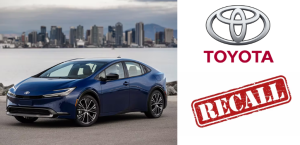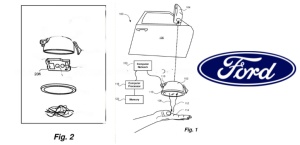By Jeff Sanford
Toronto, Ontario — March 30, 2018 — In today’s Friday Fun: Cracking down on distracted driving, the slow pace of recall repairs and much, much more!
The latest campaign by Toronto police to crackdown on distracted driving comes with a dramatic headline: “That Text or Call Could End it All.” The story goes on to note that since distracted-driving legislation came into force in Ontario in 2010, “approximately 120,000 tickets have been issued for distracted-driving-related offences” by Toronto police. Apparently data now shows that “more than 10 percent of collisions reported to Toronto police in 2016 involved at least one inattentive driver” Fines for distracted driving are set to increase again, with penalties ranging from $1,000 to $3,000 for third or subsequent incidents, as well as six demerit points for multiple offences. The new penalties would also see offenders have their licence suspended for, “three days on a first offence, seven days after two convictions, and 30 days for third and further convictions.”
-A Calgary newspaper reports this week that police in that city have charged a man in connection with a vehicle “cloning” insurance fraud scheme. According to the report, an investigation was launched in June when officers discovered a stolen Ford F-150 truck had been “re-VINed” and sold to an “unsuspecting customer.” The cloned vehicle had the VIN of another Ford F-150 that declared salvage. A stolen Toyota RAV4 had also been re-VINed and sold by a numbered company that was operating out of a local autobody shop. Another five VINs that were related to luxury cars that had been shipped offshore were also used to obtain fake registration and licence plates here.
–It was reported here more than a year ago that the small town of Innisfil, Ontario had signed a deal with Uber that allowed the ride-sharer a monopoly of business in the town in exchange for cash from the operation. Uber was looking for a test site. Innisfil said, “Why not?” Now that the experiment has run for some time there are some results to report. According to a blog post on an urban issues site, “Canada’s first ridesharing and transit partnership, Innisfil and Uber announced an expansion, adding two new flat fare destinations and a renewed financial commitment.” The deal is an interesting one: “Uber and Innisfil co-designed Innisfil Transit to offer residents flat fare rides (for $3-5) to popular destinations like the Recreation Complex, the Barrie GO Station, or the Innisfil Heights Employment Area. A standard $5 discount is applied to any other door-to-door Innisfil Transit rides beginning or ending anywhere else within the town.” The partnership launched May 2017. In the first eight months more than, “3,400 residents completed more than 26,700 Innisfil Transit trips. Additionally, the company said that over 1,300 drivers have made money by helping people get around their community.” According to a press release, “This means that more people are using the service than it was anticipated would use a bus – and at a lower cost to the town.” The report goes on to say, “The Town estimates that through the partnership, it is saving more than $8 million per year based on what an equivalent door-to-door bus system across all of Innisfil could cost.” The mayor is quoted as saying, “Innisfil Transit has had a major impact on our community, providing residents with a safe, convenient and inexpensive door-to-door transit solution that a bus system could never provide. Innisfil Transit has undoubtedly changed the lives of our residents for the better.”
-Members of a Senate committee recently complained about the pace of repairs concerning Takata airbag inflators. The recall involves some 50 million Takata inflators in the United States. To date, only about 21 million have been repaired. The Senate Commerce on Science and Transportation committee recently asked 19 automakers involved to provide vehicle repair rates. Heidi King of the National Highway Traffic Safety Administration acknowledged that repair rates are “not where we want them to be.” She said the agency is exploring new ways to reach consumers and improve response rates to recall notifications.”
-Also this week: The National Automobile Dealers Association (NADA) unveiled a new system for identifying when a car is under recall. The online service was unveiled at the NADA Show 2018 last week. According to a press release, “The free service, being put forth by the Alliance of Automobile Manufacturers and the Association of Global Automakers, with the help of vehicle-history service Carfax, will help dealers, DMVs and insurers search up to 10,000 vehicle identification numbers in 30 seconds and inform consumers about vehicles with open safety recalls.” According to a NADA exec quoted in the story, “Having a cost-free method for all dealers and others to conduct automated or batch searching of recalls will greatly enhance the likelihood that recalled vehicles get the repairs they need.”
NADA also recently reported that the percentage of dealerships operating on-site bodyshops was up in 2017 versus the previous year. Research from NADA found the percentage of dealers operating on-site bodyshops was 39 percent, up from 37 percent of dealerships in 2016. The report claims that there were approximately 6,586 dealers operating bodyshops in 2017, a 5.5 percent increase.
-The head of the main lobby group for the European bicycle industry has a neat idea. Speaking at the Geneva Motor Show, Manuel Marsilio of the Confederation for the European Bicycle Industry suggested that all bicycles be equipped with a device that can communicate with connected cars. These so-called “bicycle to vehicle” beacons would make bikes more “visible” to autonomous vehicles. The idea that connected cars will be able to communicate with infrastructure is rapidly become a reality. So-called “V2X communications” allow a car to “talk” to traffic signals and figure which car should go through the intersection first, these cars could also “talk” to bikes in the same way. According to a report, the European Union is sponsoring the development of V2X networks as part of the rollout of 5G for mobile phones. According Marsilio, “It is not easy for human drivers to see cyclists on the roads, to predict their movements, and at the same time bicycles are generally considered the most difficult detection problem that vehicle systems are currently facing.”
-A new company called Root Insurance is said to be the first car insurance company to base every one of its policies on individual driving behaviour. According to a report, “While most car insurance companies rely solely on demographic data like age, occupation and credit score to set rates, Root leverages its proprietary mobile app to give drivers customized quotes based primarily on actual driving behaviour such as hard brakes, aggressive turns, and mileage driven. Because individual driving behaviour is the biggest factor in Root’s rating algorithm, good drivers can save significantly – up to 52 percent off traditional insurance rates.” Root is backed by major reinsurance companies including Munich Re.
-Ontario’s first production plant dedicated to building electric vehicle charging stations has opened its doors north of Toronto. According to an executive at the company they will be building as many as, “40,000 charging stations a year and create 100 new manufacturing jobs over the next three years.” The venture is a joint agreement between EV equipment firm Autochargers.ca and eMotoWerks, an Italian firm. “Ontario’s centralized location makes it a perfect location for scaling Canada’s green economy, and that requires scalable EV solutions such as those from eMotorWerks,” said the company’s chief executive officer. The chargers are designed to shift EV charging load to off-peak times of day, which helps the grid remain stable. It will be interesting to see if it’s even possible to install 40,000 charging stations a year.
-Could a technology used in cars to clean exhaust also be used to make smoked meat less carcinogenic? Apparently. Smoked meats such as bacon contain cancer-causing substances. But now food industry researchers have come up with a way to remove worrisome polycyclic aromatic hydrocarbons (PAHs) from smoke without compromising flavour. By removing PAHs from the smoke used to treat meat, the resulting cuts would be safer. The idea is to use zeolite, a porous mineral used in car tailpipes to filter out harmful particles like PAHs. Using a similar process on smoked meats would see fewer of the damaging particles getting into food. Researchers claim there is no impact on taste.





































